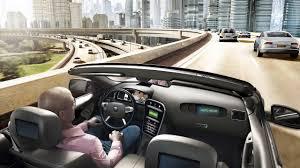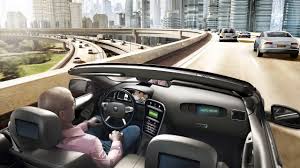
The autonomous driving technology behind the self driven cars of the future has been graded as the most hyped emerging technology of 2015 by Gartner Inc.’s Hype Cycle of Emerging Technologies report.
This however is not a single technology but a conglomeration of several technologies that are used in a synchronized manner to enable a car to drive by itself. Autonomous vehicles are the next big thing that many major auto companies are researching on and glimpse of which can be seen in some of the latest version of cars that use a host of technologies to assist driving.
The annual report by Gartner Inc. places this new technology as the most happening of the technologies being developed in 2015 ahead of technologies for the Internet of Things.
The annual report bases its decision on the nearness of any technology to commercialization and how close new technologies are to mainstream adoption, for example, less than two years away to more than 10 years off.
However even as auto manufacturing companies research and bring out new driving assistive technologies and are making continued advancements in self-driving tech, experts are of the opinion that the gap between emerging self-driving tech and fully autonomous vehicles is much wider than the prominent media coverage might suggest.
The Gartner report claims that the automated vehicle technology is driven by the progress in sensors, positioning, imaging, guidance, artificial intelligence, mapping, and communications technologies, combined with advanced software and cloud computing which are bringing the emergence of autonomous vehicles closer to reality. However the report also notes that there is a wide gap between the complexity of self-driving cars and the associated costs that come with the technologies.
“Widespread and prominent coverage by mainstream media is leading to unrealistic and inflated expectations,” the Gartner report notes.
The report clarifies that automated driving technology, while is the most hyped and talked about technological advancement in 2015, in reality, autonomous vehicles are five to 10 years away from mainstream adoption.
The primary hindrance to the adoption of the technology in real life is the costs involved which is the primary challenge. Other potential problems of commercial and real life adoption of the technology are related to legal and ethical issues such as liability.
The report predicts that even while there is a chance of real life application and adoption of the automated vehicle technology, individual country, state, and global legislation and the pace of technology innovations would define how and to what extent, this technology would be adopted and applied. The report predicts that real life application of the technology would have limited-use cases for self-driving vehicles in the short term, for example in cases of varying rules and regulations relating to low-speed city driving or highway driving.
Autonomous driving features in cars such as lane steering assistance is already part of some of the latest versions of cars manufactured by auto manufacturing companies like Audi, Tesla Motors, Daimler and BMW. This is seen as the second phase in the development of autonomous driving, as classified by Gartner Inc’s report, with the automated driving as the first phase and driverless vehicles as the last phase.
Examples of car manufacturers joining hands with tech companies to churn out assistive technologies is evident from the unveiling of the automated parking project by Bosch, Daimler and car-sharing company car2go and Tesla releasing its autopilot software to upgrade some beta testers.
(Source:www.fotune.com)
This however is not a single technology but a conglomeration of several technologies that are used in a synchronized manner to enable a car to drive by itself. Autonomous vehicles are the next big thing that many major auto companies are researching on and glimpse of which can be seen in some of the latest version of cars that use a host of technologies to assist driving.
The annual report by Gartner Inc. places this new technology as the most happening of the technologies being developed in 2015 ahead of technologies for the Internet of Things.
The annual report bases its decision on the nearness of any technology to commercialization and how close new technologies are to mainstream adoption, for example, less than two years away to more than 10 years off.
However even as auto manufacturing companies research and bring out new driving assistive technologies and are making continued advancements in self-driving tech, experts are of the opinion that the gap between emerging self-driving tech and fully autonomous vehicles is much wider than the prominent media coverage might suggest.
The Gartner report claims that the automated vehicle technology is driven by the progress in sensors, positioning, imaging, guidance, artificial intelligence, mapping, and communications technologies, combined with advanced software and cloud computing which are bringing the emergence of autonomous vehicles closer to reality. However the report also notes that there is a wide gap between the complexity of self-driving cars and the associated costs that come with the technologies.
“Widespread and prominent coverage by mainstream media is leading to unrealistic and inflated expectations,” the Gartner report notes.
The report clarifies that automated driving technology, while is the most hyped and talked about technological advancement in 2015, in reality, autonomous vehicles are five to 10 years away from mainstream adoption.
The primary hindrance to the adoption of the technology in real life is the costs involved which is the primary challenge. Other potential problems of commercial and real life adoption of the technology are related to legal and ethical issues such as liability.
The report predicts that even while there is a chance of real life application and adoption of the automated vehicle technology, individual country, state, and global legislation and the pace of technology innovations would define how and to what extent, this technology would be adopted and applied. The report predicts that real life application of the technology would have limited-use cases for self-driving vehicles in the short term, for example in cases of varying rules and regulations relating to low-speed city driving or highway driving.
Autonomous driving features in cars such as lane steering assistance is already part of some of the latest versions of cars manufactured by auto manufacturing companies like Audi, Tesla Motors, Daimler and BMW. This is seen as the second phase in the development of autonomous driving, as classified by Gartner Inc’s report, with the automated driving as the first phase and driverless vehicles as the last phase.
Examples of car manufacturers joining hands with tech companies to churn out assistive technologies is evident from the unveiling of the automated parking project by Bosch, Daimler and car-sharing company car2go and Tesla releasing its autopilot software to upgrade some beta testers.
(Source:www.fotune.com)





